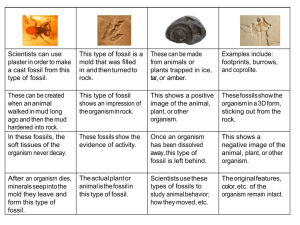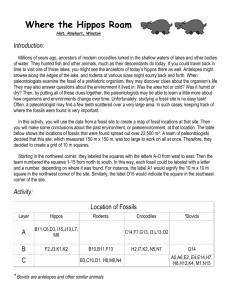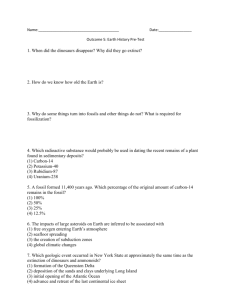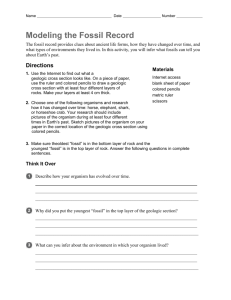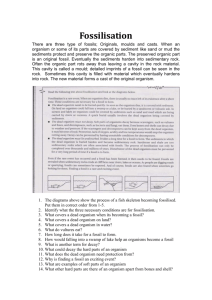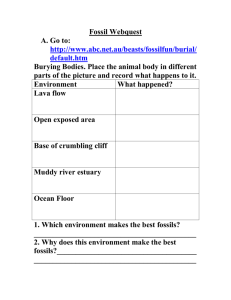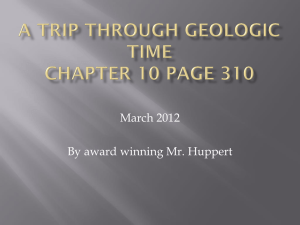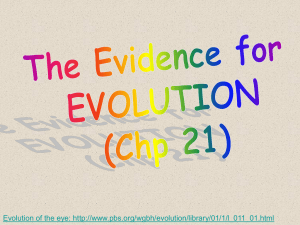The Fossil Record
advertisement
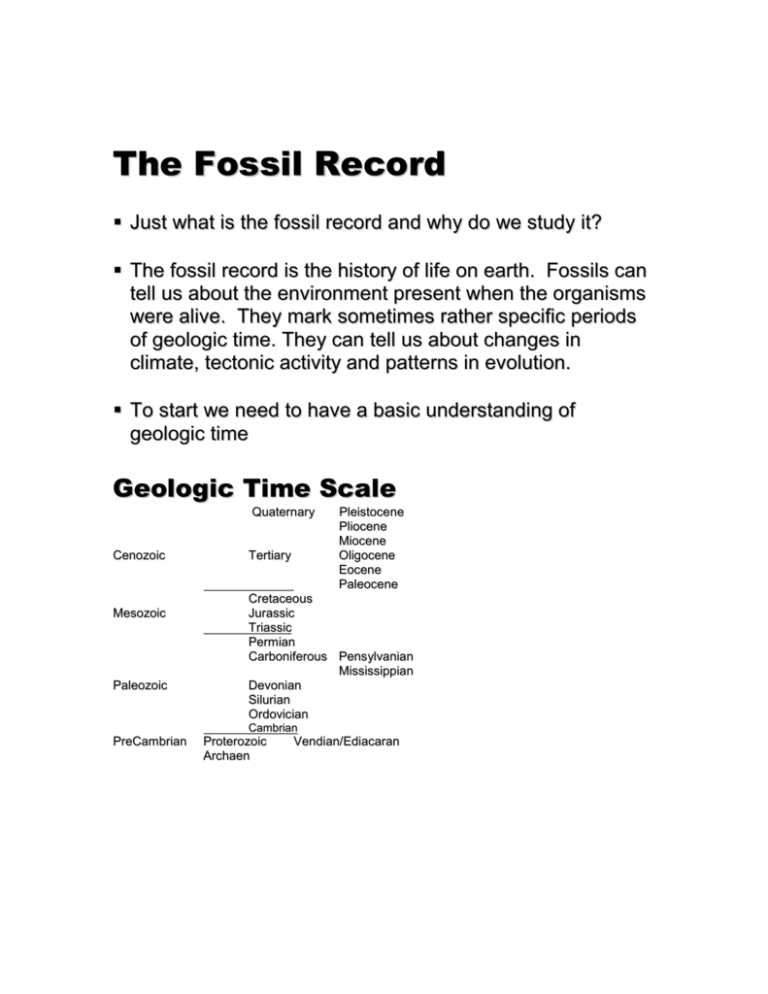
The Fossil Record Just what is the fossil record and why do we study it? The fossil record is the history of life on earth. Fossils can tell us about the environment present when the organisms were alive. They mark sometimes rather specific periods of geologic time. They can tell us about changes in climate, tectonic activity and patterns in evolution. To start we need to have a basic understanding of g e o l o g i c ti m e Geologic Time Scale Quaternary Cenozoic Mesozoic Paleozoic Tertiary Pleistocene Pliocene Miocene Oligocene Eocene Paleocene Cretaceous Jurassic Triassic Permian Carboniferous Pens ylvanian Mississippian Devonian Silurian Ordovician Cambrian PreCambrian Proterozoic Archaen Vendian/Ediacaran Geologic Time Scale Quaternary Cenozoic Mesozoic Paleozoic PreCambrian Pleistocene Pliocene Miocene Tertiary Oligocene Eocene Paleocene Cretaceous – “creta” meaning chalk Jurassic – From the Jura Mtns Triassic – 3 obvious divisions in Germany Permian – From the Perm Mtns in Russia Carboniferous Pens ylvanian – Coal bearing Mississippian Devonian – For Devon Silurian - Named for old welsh tribe Ordovician – Named for old welsh tribe Cambrian - Latin “cambria” for W ales Vendian/Ediacaran – named for a fossil fauna Zones – defined by fossil assemblages and named for one of the primary members These are index fossils Distinctive (easily identified) Geographically widespread Plentiful Facies independent Rapidly evolving Short lived (geologically) Common index fossils: Cambrian – Trilobites Ordovician/Silurian – Graptolites Devonian through Cretaceous – Ammonites Messozoic to recent - Microfauna Locally others are well known and used such as Echinoderms, specifically crinoids in the Silurian – Pennsylvanian of North America Samples of index fossils: Pentrimites sp. A blastoid from the Permian Crinoid with arms and column Crinoid calyx showing Good plate detail Other fossil organisms while widespread extend throughout too much of geologic time to serve as good indexes Brachiopods Gastropod Bivalves - oyster What is a Fossil? Recognizable evidence of past life Generally only hard parts are preserved The faster the burial, the better the chance for preservation High energy environments yield fewer fossils Trace fossils are indirect evidence of life Throughout all the early study of fossils four questions were asked: Are fossils really organic remains? How did they get into the rocks? When did they get there – while rocks were formed or sometime after? How did they become petrified? “Being a paleontologist is like being a coroner except that all the witnesses are dead and all the evidence has been left out in the rain for 65 million years. “ Mike Bret-Surman, 1994 Taphonomy (ta·fon’·omy) The study of how living organisms become fossils. This involves: Studying the processes that may have biased the sample. Or, in other words….reconstructing what has happened to the organism from the moment it died until now. Step one - what type of fossilization has happened? Types of fossilization Unaltered remains The remaining material is unaltered from the original state. Examples would be Mammoths flash frozen so that their flesh was essentially freeze dried and still edible 30,000 years later; bones from animals that were entrapped in the La Brea tar pits over 40,000 years ago; original shell material from Cretaceous molluscs and ammonites preserved in moist clays. Insects preserved in amber. Permineralization CaCO3 or Silica dissolved in ground water precipitates out in the pore spaces in the buried “hard parts” after the soft material decays. None of the original material is removed and in some cases the preservation is so detailed that cell structure can be studied. Recrystallization Some shells are made of aragonite. When the organism dies, the relatively unstable aragonite changes to the more stable calcite. The original shape of the fossil is preserved, but the larger calcite crystals distort the finer detail. Dissolution and Replacement When buried material dissolves and leaves a cavity in the sediment, that cavity can be filled with other sediment or mineral crystals. The cavity is the mold and the filling is the steinkern or cast. If the original material is replaced without leaving a void, the fossil is present, but made of non-original material – silica or pyrite perhaps. Carbonization The volatile organic materials disperse when the organism dies and a carbon film remains. This black residue preserves the outline and sometimes the internal detail of the organism. Plants, fish and graptolites may be examples of this type of preservation Will it become a fossil? What determines if an organism will become fossilized? Probably “pure, dumb luck” Biological agents – predators, bacteria, algae, vegetation all work to break down the remains…. Rapid Burial is a must! Mechanical agents – wind, wave action, currents (both air and water), the energy of the environment…the most durable parts will survive the longest before burial Diagenesis – action of groundwater can remove shell and bone before they have a chance to be preserved. Original composition and groundwater chemistry are critical factors. Discovery – the fossils have to be in a place where they will be available to the paleontologist for study Considering all the factors, the odds of an organism becoming a fossil and then being discovered are extremely s m al l . Of the nine phyla of marine invertebrates that fossilize well, it is estimated that 85-97% of all the species that ever lived have never been fossilized. Much easier to study the higher taxonomic levels than the lower ones….. Lagerstätten Extraordinary fossil localities around the world. The ones any paleontologist would give anything to find and publish. Burgess Shale – Middle Cambrian, British Columbia Solnhofen Limestone – Upper Jurassic, Southern Germany Mazon Creek – Pennsylvanian, NE Illinois
